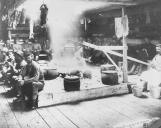1
The lumber industry in the Gatineau ValleyPhilemon Wright (1760-1839) was the first to develop the economic potential of the Gatineau region. In 1800, he settled in what would become Hull. From the time he floated the first logs down the Ottawa River, logging shaped the life and landscape of the Gatineau Valley.
In Europe, the blockade issued by Napoleon in 1806 prevented England from receiving supplies of Baltic timber. England had no choice but look across the ocean to its North American colony to find the timber it needed to build the ships of the Royal Navy. This historical event marked the birth of the forest economy in the Outaouais. In the following decades, businessmen set up logging camps and men came to the region to earn wages cutting timber. Families established farms, and towns sprang up to serve the logging camps. The seasonal cycle of logging was especially visible each spring when the logs that were cut in winter filled the Gatineau River for their journey to the many sawmills on the Ottawa River.
In the 1850s, demand for square timber collapsed, but fortunately for the lumber merchants and the settlers of the region, there was a growing demand for sawn lumber to feed the booming American market. Logs were carried down the river to the mills on the Ottawa River where they were cut into planks. In 1883, prices began to decline, but once more the forest economy was quickly revitalised by the pulp production market. The sawn lumber trade did not end completely but continued, though on a much smaller scale, until the 1920s.
In summer, the timber cruiser went into the forest within his employer's landholdings to locate timber to cut during the coming winter. He travelled on foot and by canoe, portaging between rivers and lakes. He visited the farms that were to supply the shanties in order to estimate their yields, particularly the feed for the draught animals used in the woods in winter.
The logging industry employed the vast majority of its workers during the winter. A lot of these men were local farmers, supplementing their summer incomes. They left for the woods at the end of September, preceded by the teamsters and their horses, and did not come home before springtime, often leaving their wives to care for their farms and children, alone for the winter. The men lived in shanties, which were self-sufficient communities of between 30 to 120 men, under the supervision of a foreman and a shanty clerk. Each shanty had its own cook. Besides the log houses where the men slept, there was usually a store, a cellar, and a blacksmith shop at the site of each logging camp.
Each spring, after wood had been cut and piled along streams and riverbanks, the log drivers would eagerly await the thaw. They would push the logs into the water and follow them with pointer boats, helping the log booms make their way down the Gatineau River toward the sawmills. Pointer boats were used from the early 19th century until the construction of the dams in the 1920s. Following the damming of the Gatineau River, the river was too slow and the log booms had to be towed along by tugboats. When logs jammed or needed extra help to move along, the drivers would balance on the floating logs and use long pike-poles to pull or hook the logs to keep them moving down the river.
Bibliography:
Gatineau Valley Historical Society Files
Gaffield, Chad: History of the Outaouais. Quιbec: Institut quιbιcois de recherche sur la culture, 1997, 843 p.
Hughson, John Ward and Bond, Courtney C. J.: Hurling down the Pine: the story of the Wright, Gilmour and Hughson families, timber and lumber manufacturers in the Hull and Ottawa region and on the Gatineau River, 1800-1920. Chelsea (QC), Historical Society of the Gatineau, Third Edition, 1987, 130 p.
2
Allan Gilmour, 1846-190319th Century, Circa 1876
Chelsea, Quebec, Canada
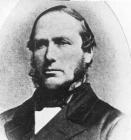 Credits:
Credits:GVHS Archives, 00550.001.005
3
Gilmour Lumber Company office, circa 188619th Century, Circa 1886
Point Comfort, Quebec, Canada
 Credits:
Credits:GVHS Archives, 02425.001.a033
4
Extracts from John Mather's diary (Woods Manager of the Gilmour Company), circa 185919th Century, August 1859
Gatineau Valley, Quebec, Canada
Transcription of handwritten diary:
"August 11, 1859
Left mills got started from Kirks with canoe at half past 7 reached Lapκche at 10 o'clock [arranged] with [ ] Chamberlin to [ ] house for £100 reached Paugan at 3 o'clock leaving the [4] Indians to take the canoe to [ ]. Mr. Moffat surveyor went on with me to [ ] arrived at 8 o'clock told [ ] to go to the mills on Saturday [ ].
August 13
Breakfast started ½ past 5 o'clock reached Desert at 10 a.m., had dinner and started with surveyor to find the [ ].
August 14, Sunday
Left Desert ½ past 5 a.m. for Joseph Farm accompanied by surveyor [ ] 4 Indians could [ ] to [show] the position of the farm in the Townships after [ ] a while got the division line between Kensington [ ] but could find no posts [ ].
August 16
The crops on Joseph's Farm look very well, a large quantity of potatoes from appearance should serve 2 shanties the foreman [ ].
August 18
Left Desert for up river found [ ] Eddy improvement all in good order some loose stones must be removed from bottom of slide paddled up 4 [Wilson Chute] [ ] went by portage [ ] to the new farm found the crops [ ] looking well gave orders for cutting all the Beaver Bay in the locality showed them how to divide the new houses returned to camp in the evening raining very hard got wet through and did not get dry.
August 19
Started early reached Baskatong 6 p.m. [ ] of hay say 30 tons the oats look beautiful [ ] farm in good order buildings [ ] satisfactory [ ].
August 20
Left Baskatong Farm at 10 o'clock a.m. arrived at [ ] ½ past 12 took dinner and proceeded to the [ ] appears to be 1/2 of the Gatineau and is wide and beautiful with nice clean [banks] here and there [ ] of the river the banks are giving way and show pure yellow sand. Reached Hamilton Farm at dark 20 miles from the mouth [ ].
August 22, Monday
Started after breakfast at 6 a.m. paddled up [ ] the 27 ½ miles from mouth [ ] portaged into Grasshopper River and from that into La Riviθre de [ ] continued until we reached Bark Lake [ ] 8 miles and camped on an island [ ].
August 23
Left camp at 6 a.m. paddled up the Lake Bark. Lake is very [ ] in width and varies from Ό mile to 8 or 10 and filled with islands the general course of the lake is for about 20 miles west and for 40 or 50 miles north [ ] there appears to be large quantities of pine on both sides - on the south west side and towards the Desert and Coulonge the Indians report on large quantity of pine timber [ ] at the head of the Coulonge is principally red pine [ ] good white pine and would come down the south branch of the [ ] into Bark Lake [ ].
August 27
This morning [ ] find a good deal of timber in two different [ ] and along the side of the Lake River the timber on this lower end is much better than that on the upper trees much longer and much [ ] I do not think that all this limit would produce 30,000 good logs after dinner started to come down the Jean de Terre through the rapids and [ ] and reached about 33 miles from the mouth [ ]."
Credits:LAC, John Mather Fonds, Reel M-234
5
Gilmour's Mills on Gilmour's Island, Chelsea, 188319th Century, July1883
Chelsea, Quebec, Canada
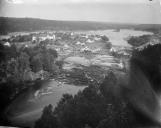 Credits:
Credits:Topley Studio Fonds, Library and Archives Canada, PA-027068
6
Eddy's Number 3 camp, north of Maniwaki20th Century
North of Maniwaki, Quebec, Canada
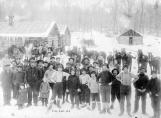 Credits:
Credits:Boyle Collection / GVHS Archives, 00638.006
7
Lumber workers in the Gatineau and Coulonge areas20th Century
Coulonge, Quebec, Canada
 Credits:
Credits:GVHS Archives, 00827.008.006
9
Ronald Gauvreau sings 'La chanson des Lafreniθre'20th Century
Gatineau Valley, Quebec, Canada
 Credits:
Credits:Lucien Ouellet Collection
http://epe.lac-bac.gc.ca/100/205/301/ic/cdc/vallee/indexcredits.htm
10
A lumber worker reminisces about lumbering in the Gatineau Valley, circa 191320th Century, Circa 1913
Gatineau Valley, Quebec, Canada
Book excerpt:
"Learning the lumber business kept me out of doors exposed to all kinds of weather, freezing in the woods in below-zero cold or broiling in the reverberating heat of the lumber piles in summer, soaked with water and bitten by black-flies and mosquitoes in the spring, soaked with rain and river and muskeg in the autumn. Breakfast came at 5 a.m. in the shanties, and dog-tired bodies were flat in the bunks by eight in the evening. [ ].
In the winter the walk from the shanty out to the places where the crews were cutting was also a trial. Winds howled in the open places, and we used to swear the temperature went down to 60Ί below. Under those conditions, it took a half an hour to go a mile. [ ].
The meals were rather trying to a shanty-dweller who wasn't engaged in heavy manual labour, for they were planned to nourish a hard-working man. They were very high calorie foods, to provide energy that was expended at rapid rates in the Canadian winters, or on the drive and the sweep in the spring and autumn. "Heartburn" was a frequent experience for me. Picture a bowl of white beans floating in lard as breakfast cereal, followed by fried fat salt-pork, with a slice of pie to follow, all washed down with a pannikin of Japanese green tea that had probably boiled for hours, with no milk to cut the acid! [ ]. Lunch in the woods usually consisted in cold boiled salt-pork, lots of shanty-made bread, and some more of the green tea, boiled over a camp-fire at the lunch-site. Back in camp, evening meal was like the breakfast menu, except that there would be "sea-pie" or baked beans. Desserts included well-stewed prunes, dried apricots or apples, and on occasion raisin pie. [ ]."
Credits:HUGHSON, John. W.: "Reminiscences". Hurling Down the Pine, The Historical Society of the Gatineau, 1964, Third Edition, 1987, pp. 119-120.
11
Men and birchbark canoe next to the shanty20th Century
Chelsea, Quebec, Canada
 Credits:
Credits:GVHS Archives, 00560.001.005
12
John Hughson's recollection of an encounter with a group of Abenakis, circa 191420th Century, Circa 1914
Bark Lake, Quebec, Canada
Book extract:
"It is trite to say it, but nonetheless, how times have changed! The Indians ranged all over the lands where we cut. I recall one day at the Bark Lake post when there appeared up the lake a big flotilla of canoes. As it came near one could distinguish their identity: these were Abenaki from the upper headwaters of the Ottawa, whole families of them, coming to trade at our post. Music filled the air from gramophones in some of the canoes."
Credits:Hurling Down the Pine, The Historical Society of the Gatineau, 1964, Third Edition, 1987, p. 122.
13
Bingham logs at Cascades - log driving, Gatineau River, August, 190020th Century, August 1900
Cascades, Quebec, Canada
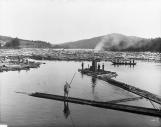 Credits:
Credits:Topley Studio Fonds / Library and Archives Canada, PA-008919
14
Log jam on the Gatineau River, circa 192020th Century, Circa 1920
Cascades, Quebec, Canada
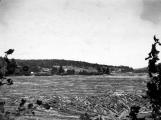 Credits:
Credits:GVHS Archives, 01750.004
